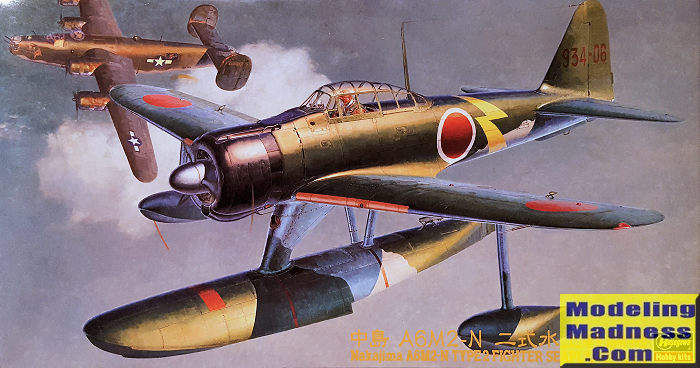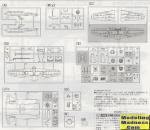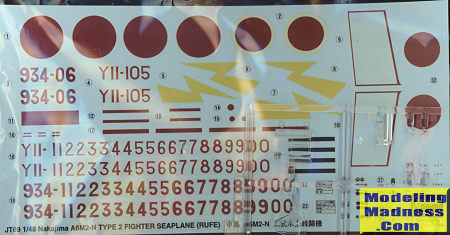
|
HISTORY |
Hasegawa 1/48 A6M2-N 'Rufe'
|
KIT # |
09069 (Jt69) |
|
PRICE: |
2400 yen |
|
DECALS: |
Two options |
|
REVIEW : |
|
|
NOTES: |
1999 release. |

|
HISTORY |
The history of the A6M Zero-Sen has been well documented in
other reviews. The floatplane fighter version, Allied code-named 'Rufe' was
developed by Nakajima in response to a request by the Japanese Navy for a float
fighter based on the A6M2. This was mainly due to the Japanese inability to
quickly build runways. There was no Japanese equivalent of the Seabees to do
this. Therefore the need for defending fighters that could take off from and
land on the water to defend any newly acquired ocean-front property. Like their
seaplane buddies, many 'Rufe' units operated from a tender.
While
a new fighter specifically designed for this purpose, the Kawanishi N1K1 'Rex'
was being developed, it would be years before it was operational. Undertaking
the job of converting the A6M2, Nakajima had a prototype flying in less than a
year from initial development, first flying on 7 December 1941. There were
327 'Rufes' built and they saw action in nearly all theaters of the war in the
Pacific, being used right up until the end of the war. The first deployment of
the type was to a sleepy little bug-infested island in the Southwest Pacific
called Tulagi, across a strait from a larger, even more inhospitable place that
no one ever heard of called Guadalcanal. Where enemy fighter
opposition was light or weak, the 'Rufe' did well. Even against more advanced
types, 'Rufe' pilots were able to score well and a few 'Rufe' pilots became
aces.
|
THE KIT |
The rest of the kit is up to the same standards as the rest of
Hasegawa's A6M line and you will have quite a few spares, especially landing
gear parts.
As one expects from Hasegawa, the molding is superb with the
usual finely engraved panel lines and flash free parts. Buying an aftermarket
cockpit for this kit is not really needed and one can certainly add a bit to it
by drilling the seat holes and installing a seat belt. Note that rarely was a
shoulder harness used in floatplanes. This kit is also the initial release.
REFERENCES Japanese Aircraft of the Pacific War, by Rene J
Francillon Camouflage and Markings of IJN Fighters, Model Art #510 Review copy courtesy of me and my wallet! Copyright ModelingMadness.com. All rights reserved. No
reproduction in part or in whole without express permission from the editor. If you would like your product reviewed fairly and fairly quickly, please contact
the editor or see other details in the Note to
Contributors. Many of the sprues
for the 'Rufe' are common to the earlier A6M2 kits that Hasegawa has produced.
However, about half of the kit is new, consisting of a new fuselage (the 'Rufe'
had a larger rudder), new lower wing, center float and stabilizing wing floats.
There is also a nice beaching trolley for you to display your new kit upon. Most
of the trolley is on the sprue with the new lower wing while the wheels are on
the sprues for the floats, bombs and racks. The third new sprue is for the main
float. You'll need 16 grams in this float to keep it from 'tail sitting'.
Many of the sprues
for the 'Rufe' are common to the earlier A6M2 kits that Hasegawa has produced.
However, about half of the kit is new, consisting of a new fuselage (the 'Rufe'
had a larger rudder), new lower wing, center float and stabilizing wing floats.
There is also a nice beaching trolley for you to display your new kit upon. Most
of the trolley is on the sprue with the new lower wing while the wheels are on
the sprues for the floats, bombs and racks. The third new sprue is for the main
float. You'll need 16 grams in this float to keep it from 'tail sitting'.
 There are
two markings options included. One is the box art kit from the 934th Flying
Group based on Ambon Island in 1943. You are provided two different size
fuselage lightning bolts so use either one. The other is an overall brown-grey
plane from the Kamikawa Maru seaplane tender. This plane is overall brown grey.
Note that you are provided multiple numbers so can do any airplane from these
units. Decals are old school so a bit thick with off-white whites on the
fuselage insignia.
There are
two markings options included. One is the box art kit from the 934th Flying
Group based on Ambon Island in 1943. You are provided two different size
fuselage lightning bolts so use either one. The other is an overall brown-grey
plane from the Kamikawa Maru seaplane tender. This plane is overall brown grey.
Note that you are provided multiple numbers so can do any airplane from these
units. Decals are old school so a bit thick with off-white whites on the
fuselage insignia.